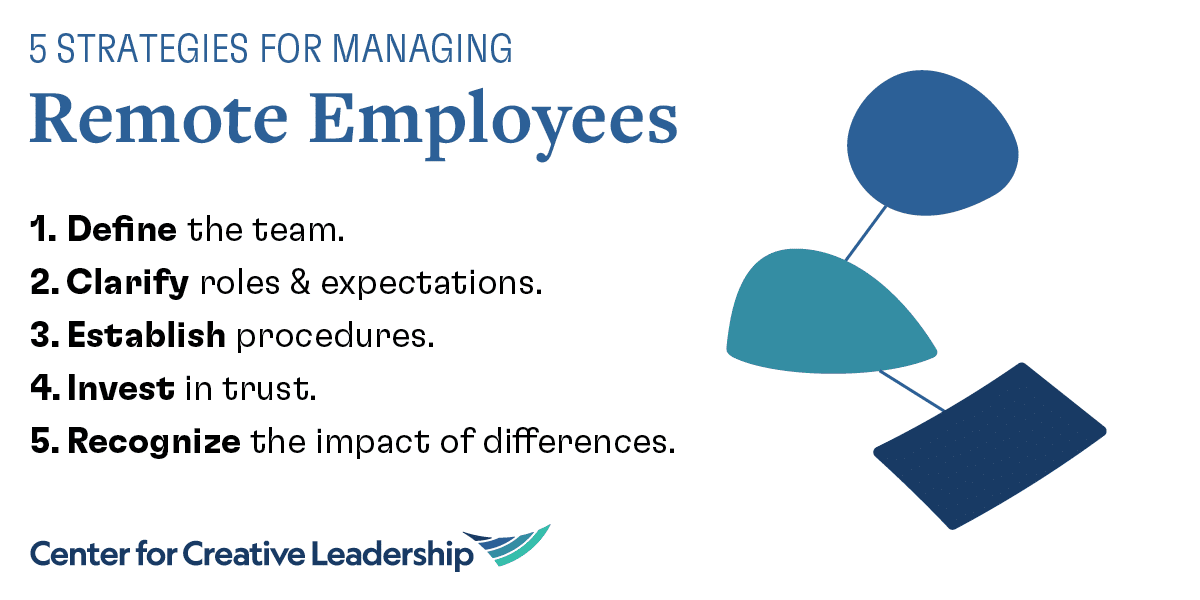Apply These Strategies When Supporting Geographically Dispersed Teams
Even in the best of circumstances, leading a high-performing team can be a challenge. But when team members are working from home, scattered geographically, and separated culturally, the task of managing remote employees is even greater.
More and more, global organizations expect geographically dispersed teams to deliver high performance and innovation. But cultural differences often lead to radically different perspectives — and it’s up to team leaders to bridge those differences.
Though they don’t have the benefit of in-person communications, team leaders can take steps to steer their dispersed teams in a positive direction.
5 Strategies for Managing Remote Employees
Organizations and their team leaders should utilize the following 5 strategies to build and support geographically dispersed teams, based on the tips we recommend in our guidebook, Leading Dispersed Teams.
1. Define the team.
If you’re starting a new team from the ground up, be clear from the beginning about the team’s purpose. What tasks do you expect your team to complete? Explain why those tasks are important so that team members understand the big picture and meaning behind what they’re working to accomplish.
If you’ve inherited a team or are struggling with your existing team, take some time out to understand the team’s purpose and vision — and be sure you and your team members are on the same page. To be effective in the face of different perspectives and experiences, it’s important for your team to unite around a shared purpose and vision.
2. Clarify roles and expectations.
Now that you’ve all agreed on your team’s purpose, ensure there’s a clear direction for completing the tasks required to accomplish your mission.
Geographically dispersed team members require tactical direction.
For example, what specific tasks or perspective do you expect each team member to contribute? Because team members may not understand why they’ve been chosen, schedule a meeting to share why each member was named to the team, each person’s unique background and valuable skill set, and clarify the role that each member is expected to play.
A team charter can help you stay on track, clarify roles, and meet your objectives. Read more about how to keep your team on track with a team charter.
3. Establish procedures.
With everyone in agreement on a set of clear team member roles and responsibilities, share a game plan for how your team should interact with each other.
Our experts have found that team members spread across multiple time zones often end up working long hours to accommodate each other’s schedules. These unrealistic schedules lead to low productivity and burnout.
Additionally, in different facilities and in different cultures, routine processes often differ widely, which can leave team members confused.
Team leaders should establish norms and provide training for best practices such as meeting formats, use of technologies and communication, and decision-making. See more best practices for managing virtual teams and meetings.
4. Invest in trust.
Now that you’ve set the direction for your team and you’ve coordinated alignment, it’s time to get the commitment. In other words, you want to ensure that each team member feels responsible for your group’s outcomes.
That requires trust, and here’s where things get tricky for you as a team leader.
Dispersed teams often struggle to build and maintain trust. Not only do they lack the physical proximity that encourages feelings of cohesiveness, but often members are unsure how to address cultural differences.
To build team trust, there are things you can do in the short-term, such as:
- Periodically hold virtual “face-to-face” meetings to build rapport.
- Keep the team informed of long-term organizational changes.
- Ask for team input on critical organizational issues.
- Celebrate short-term wins, reinforcing the team’s shared effort.
Perhaps most importantly, understand that trust will come with time, and focus on the long term rather than expecting overnight cohesion of the team.
Access Our Webinar!
Watch our webinar, Leading Remote Teams When the Stakes Are High, which covers the mindset, skillset, and toolset needed to effectively lead remote teams.
5. Recognize the impact of differences.
Dispersed team members often have a love-hate relationship with virtual teamwork. While they may love new tools for virtual collaboration, they may struggle with best practices for virtual communication. They may love learning about different cultures, but hate the misunderstandings that result from a language barrier. Some may love the autonomy of working remotely, but also feel out of the loop and isolated at the same time.
Particularly when English has become the language of doing business, as it has in much of the world, it may be tempting to assume common mindsets and values. But it’s important for those leaders who are managing remote employees to remember that their members have unique experiences and perspectives, and leading a multicultural team requires leadership skill.
As a leader, consider your own cultural assumptions and behaviors. Take care to ensure that your choices and actions reflect the considerations of not just your thinking, but of your group members’ preferences, as well.
And when you schedule meetings and delegate responsibilities, be sure to factor in cultural considerations such as social status, language challenges or barriers, time differences, and distance. All of these factors impact team members’ ability to participate and contribute, and your effectiveness at leading from a distance depends upon you being able to take those differences into account.
Ready to Take the Next Step?
If you’re ready to develop your leaders in best practices for managing remote employees, partner with us to craft a customized learning journey for your team using our research-backed modules. Available leadership topics include Authenticity, Collaboration & Teamwork, Communication, Emotional Intelligence, Listening to Understand, Psychological Safety, Virtual & Remote Team Leadership, and more.









